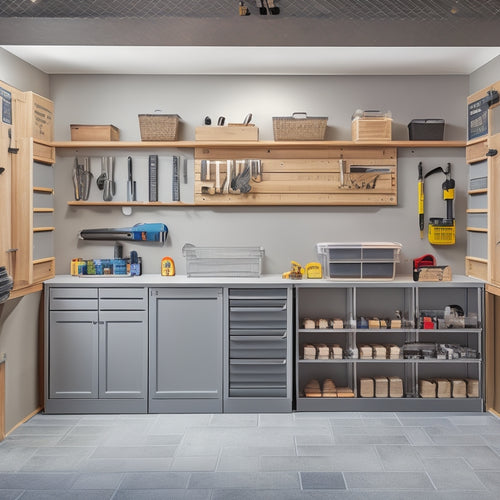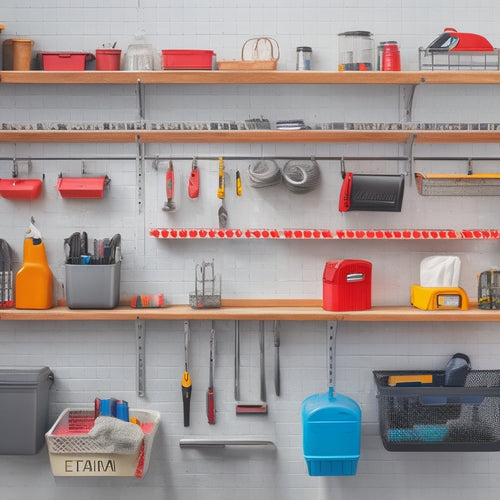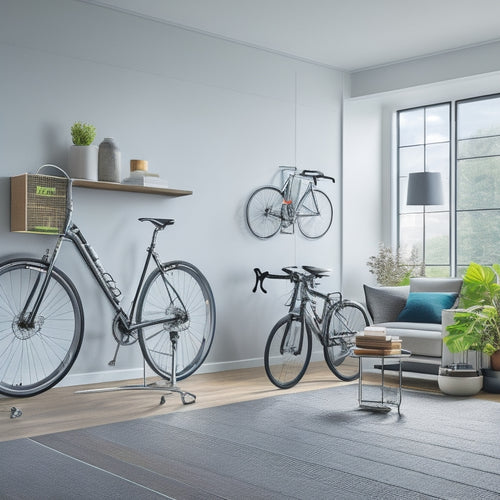
Design Considerations for a Custom Pegboard
Share
When designing a custom pegboard, you'll want to start by evaluating your storage needs, considering factors like tool frequency, size, and weight. Next, choose materials that balance durability and aesthetic appeal, selecting heavy-duty options for heavy tools and lighter ones for smaller accessories. Then, determine the ideal pegboard size and layout, applying the "golden zone" principle and maintaining adequate spacing to prevent overcrowding. As you finalize your design, consider customization options, such as customized hook types and organizational tools, to guarantee your pegboard streamlines your workflow and enhances productivity - and that's just the starting point for creating a truly efficient workspace.
Key Takeaways
- Assess frequently used items for pegboard suitability, considering frequency, size, and weight for optimal placement and workflow.
- Balance durability and aesthetic appeal when selecting materials, choosing heavy-duty options for heavy tools and lighter materials for small accessories.
- Determine pegboard size based on installation space and tool quantity, applying the "golden zone" principle for tool placement and adequate spacing.
- Select various hook types and organizational tools to accommodate different tools and small items, choosing colors that contrast with tools for improved visibility.
- Tailor pegboard design to specific tasks or workflows, positioning frequently used tools at an adjustable height to reduce strain and enhance productivity.
Defining Your Storage Needs
When organizing your workspace, a pegboard can be a useful asset, but only if it's customized to your specific storage needs. To define these needs, take stock of the items you use regularly and identify the ones that can be stored on a pegboard. Consider the frequency of use, size, and weight of each item to determine the ideal placement and hook type.
Next, assess your available space to determine the maximum size of your pegboard. Measure the area where the pegboard will be mounted, considering any obstacles or limitations. This will help you enhance the space and guarantee the pegboard fits seamlessly into your workflow.
Prioritize item accessibility by grouping similar items together and placing frequently used items in easy-to-reach locations. This will streamline your workflow, reduce clutter, and increase productivity.
Choosing the Right Materials
With your storage needs defined, it's time to select the materials for your custom pegboard. You'll want to choose materials that balance material durability and aesthetic appeal. A pegboard made from low-quality materials may not withstand the weight of your tools or equipment, compromising safety and functionality.
When selecting materials, consider the weight and type of items you'll be storing. For example, if you'll be hanging heavy tools, you may want to opt for a pegboard made from thick, heavy-duty materials like 1/4-inch or 1/2-inch plywood or MDF. Thinner materials like 1/8-inch plywood or plastic may be suitable for lighter items like hooks or small accessories.
Additionally, think about the environment in which your pegboard will be used. If it'll be exposed to moisture or extreme temperatures, you may want to choose materials that are resistant to these conditions, such as waterproof or rust-resistant materials.
Pegboard Size and Layout
You've selected the ideal materials for your custom pegboard, now it's time to focus on the pegboard's size and layout. The size of your pegboard will depend on the space available for installation, the number of tools you need to store, and the frequency of use.
Consider the "golden zone" principle, where the most frequently used tools are placed within easy reach, typically between 30 and 40 inches from the floor.
When determining the layout, think about pegboard orientation. Will it be mounted horizontally, vertically, or at an angle? This decision will impact the ergonomics and accessibility of your tools.
Guarantee adequate pegboard spacing to prevent overcrowding and promote easy tool retrieval. A general rule of thumb is to maintain a minimum of 1 inch between hooks and 2 inches between rows. Proper spacing will reduce the risk of tool damage and accidents.
Accessories and Hardware Options
Your custom pegboard's functionality and versatility rely heavily on the accessories and hardware you choose to complement it. The right combination will enhance your pegboard's organizational capabilities, while the wrong choices can lead to clutter and safety hazards.
| Accessory/Hardware | Factors |
|---|---|
| Hook types | Choose from a variety of hook types (e.g., bin hooks, tool hooks, screw-in hooks) to accommodate different tool sizes and weights. |
| Organizational tools | Add bins, baskets, and trays to store small items and keep them organized. |
| Color choices | Select colors that contrast with your tools and equipment to improve visibility and reduce eye strain. |
| Mounting options | Decide on mounting methods (e.g., screws, adhesive, magnets) based on your pegboard's material and the weight of your tools. |
| Spacing strategies | Plan spacing to guarantee easy access and to prevent overcrowding, which can lead to accidents and damage. |
When selecting accessories and hardware, remember to take weight limits into account to prevent your pegboard from collapsing or becoming unstable. By making informed choices, you'll create a custom pegboard that meets your specific needs and guarantees a safe working environment.
Customization for Specific Tasks
When designing a custom pegboard, frequently you'll need to tailor it to specific tasks or workflows to maximize its efficiency and utility. This involves carefully selecting task-specific tools and arranging them in a way that optimizes your work process.
Consider the tasks you'll be performing most frequently and position the corresponding tools at an adjustable height that reduces strain and discomfort. For instance, if you're a mechanic, you may want to position your most-used wrenches and pliers at a comfortable arm's length to minimize bending and reaching.
Additionally, think about the sequence of tasks you'll be performing and arrange your tools accordingly. By doing so, you'll be able to complete tasks quickly and efficiently, reducing the risk of accidents and injuries.
A well-designed custom pegboard can greatly improve your productivity and safety, making it an essential investment for any workspace.
Frequently Asked Questions
Can I Use a Pegboard in a Humid or Outdoor Environment?
You can use a pegboard in humid or outdoor environments if you select materials with high humidity resistance, such as stainless steel, aluminum, or polymer-coated pegs and panels, to guarantee durability and safety.
How Do I Prevent Pegs From Getting Stuck or Jammed?
When using pegboards, you'll want to prevent pegs from getting stuck or jammed by selecting peg materials with low friction coefficients and optimizing peg spacing to guarantee smooth insertion and removal, minimizing the risk of damage or injury.
Are Pegboards Suitable for Heavy-Duty or Industrial Use?
When you're considering heavy-duty or industrial use, you'll need a pegboard built with heavy-duty materials and a sufficient thickness to withstand the weight and stress, ensuring a safe and reliable storage solution that won't fail under heavy loads.
Can I Mount a Pegboard on a Curved or Angled Surface?
When mounting a pegboard on curved or angled surfaces, you'll need to adapt your mounting techniques to guarantee stability and safety. Consider using adjustable brackets or custom-fit fasteners to securely attach the pegboard, confirming it remains level and secure.
Are Pegboards Compatible With Existing Tool Storage Systems?
You investigate the theory that pegboards seamlessly integrate with existing tool storage systems, and indeed, they do, allowing you to optimize space and enhance tool organization, thereby streamlining your workflow and ensuring a safer working environment.
Conclusion
By carefully considering your storage needs, material selection, pegboard size, and accessories, you'll create a custom pegboard that maximizes efficiency and streamlines your workflow. Research supports the theory that a well-designed pegboard can reduce tooling time by up to 30%, leading to increased productivity and cost savings. Don't settle for a generic solution – invest in a custom pegboard that's customized to your specific tasks and needs, and reap the benefits of a more organized and efficient workspace.
Related Posts
-

Essential Steps for Garage Storage System Design
You're about to change your cluttered garage into an organized haven by following a structured approach to garage sto...
-

3 Simple Steps to a Garage Tool Wall You'll Love
To create a garage tool wall you'll love, start by planning the space, taking inventory of your tools, and measuring ...
-

Must-Try Bike Storage Ideas in Small Spaces
You're tired of sacrificing precious living space to store your bike, especially in small homes where every square fo...


